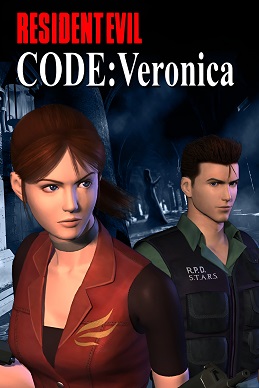Resident Evil Code: Veronica
| Resident Evil – Code: Veronica | |
|---|---|

North American Dreamcast cover art
|
|
| Developer(s) |
Capcom Nextech |
| Publisher(s) |
Capcom
|
| Director(s) | Hiroki Kato |
| Producer(s) | Shinji Mikami |
| Programmer(s) | Yukihiko Tani |
| Artist(s) | Junichi Ota |
| Composer(s) | Takeshi Miura |
| Series | Resident Evil |
| Platform(s) | Dreamcast PlayStation 2 (X) GameCube (X) Xbox 360 (X HD) PlayStation 3 (X HD) |
| Release |
February 3, 2000
|
| Genre(s) | Survival horror |
| Mode(s) | Single-player |
| Aggregate score | |
|---|---|
| Aggregator | Score |
| GameRankings | 94% |
| Review scores | |
| Publication | Score |
| AllGame | |
| Edge | 8/10 |
| EGM | 9.7/10 |
| Famitsu | 35/40 |
| GamePro | |
| Game Revolution | A- |
| GameSpot | 9.5/10 |
| IGN | 9.2/10 |
| Author | S. D. Perry |
|---|---|
| Country | United States |
| Language | English |
| Series | Resident Evil |
| Genre | Horror |
| Publisher | Pocket Books |
|
Publication date
|
December 1, 2001 |
| Media type | Print (Paperback) |
| Pages | 230 |
| ISBN | |
| OCLC | 433622107 |
| Preceded by | Nemesis |
| Followed by | Umbrella Chronicles SIDE A & SIDE B |
Resident Evil – Code: Veronica, known in Japan as Biohazard – Code: Veronica, is a survival horror video game developed and published by Capcom and originally released for the Dreamcast in 2000 . It is the fourth major installment in the Resident Evil series and the first to debut on a non-Sony platform, in contrast to the first three installments which were originally released on the PlayStation. The story takes place three months after the events of Resident Evil 2 (1998) and the concurrent destruction of Raccoon City as seen in Resident Evil 3: Nemesis (1999). It follows Claire Redfield, her brother Chris Redfield, and friend Steve Burnside in their efforts to survive a viral outbreak at both a remote prison island in the Southern Ocean and a research facility in Antarctica. The game retains the traditional survival horror controls and gameplay seen in previous series installments; however, unlike the pre-rendered backgrounds of previous games, Code: Veronica utilizes real-time 3D environments and dynamic camera movement.
Code: Veronica was developed in tandem with Resident Evil 3: Nemesis. Although not a numbered release, the developers describe the game as the true sequel to Resident Evil 2. Code: Veronica has received critical acclaim, and has been considered both among the best Resident Evil and Dreamcast games of all-time. An updated version of the game, titled Code: Veronica X, includes new cutscenes along with mild graphical changes. This revision was released for the Dreamcast in Japan and for the PlayStation 2 worldwide in 2001, eventually being ported to the GameCube in 2003. A high-definition remaster was released for the Xbox 360 and PlayStation 3 in 2011.
...
Wikipedia
